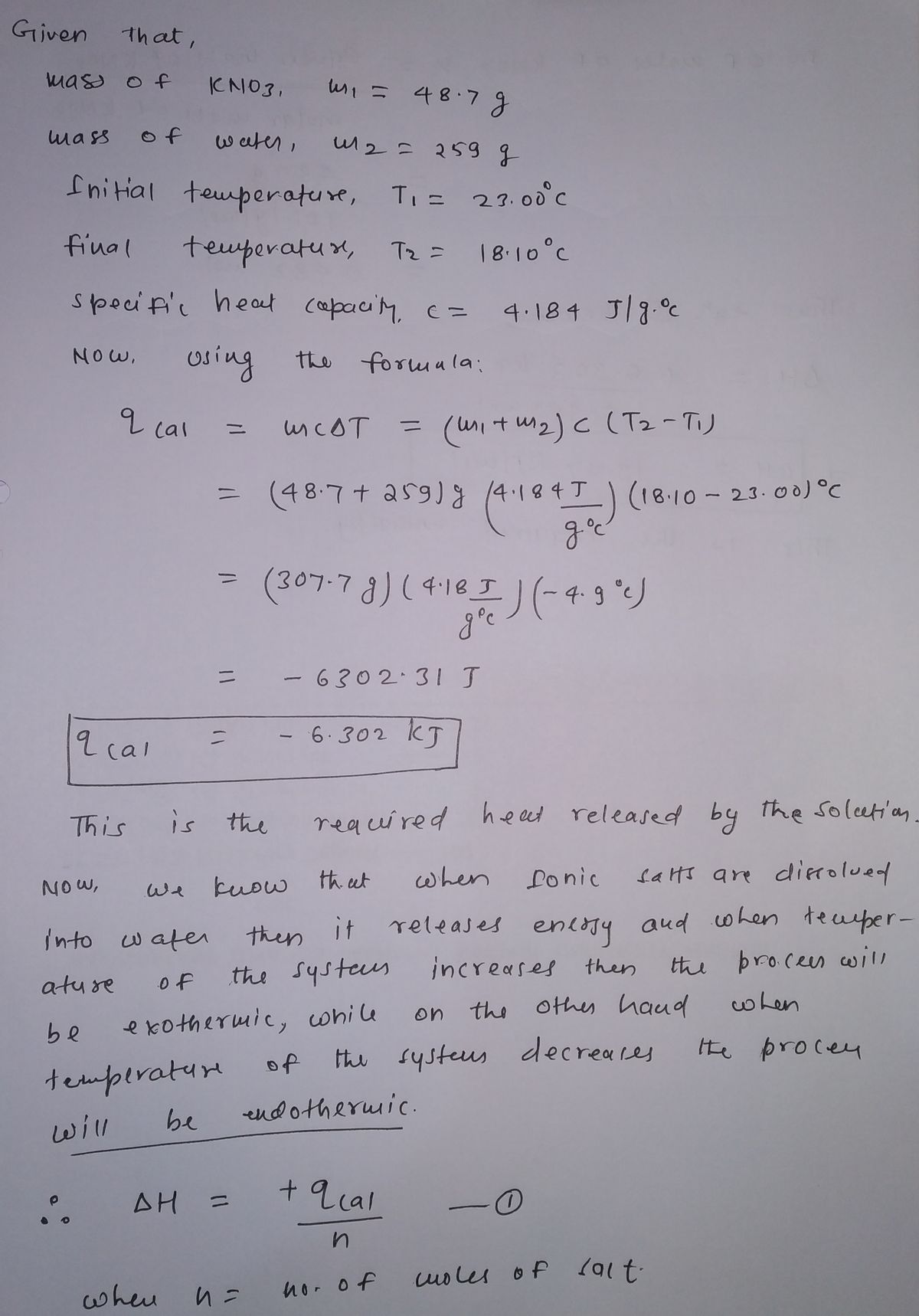Potassium nitrate, KNO,, has a molar mass of 101.1 g/mol. In a constant-pressure calorimeter, 48.7 g of KNO, is dissolved in 259 g of water at 23.00 °C. H,0 KNO, (s) K*(aq) + NO, (aq) The temperature of the resulting solution decreases to 18.10 °C. Assume that the resulting solution has the same specific heat as water, 4.184 J/(g · °C), and that there is negligible heat loss to the surroundings. How much heat was released by the solution? 4soln = kJ What is the enthalpy of the reaction? ΔΗΧ kJ/mol rxn
Potassium nitrate, KNO,, has a molar mass of 101.1 g/mol. In a constant-pressure calorimeter, 48.7 g of KNO, is dissolved in 259 g of water at 23.00 °C. H,0 KNO, (s) K*(aq) + NO, (aq) The temperature of the resulting solution decreases to 18.10 °C. Assume that the resulting solution has the same specific heat as water, 4.184 J/(g · °C), and that there is negligible heat loss to the surroundings. How much heat was released by the solution? 4soln = kJ What is the enthalpy of the reaction? ΔΗΧ kJ/mol rxn
Chemistry
10th Edition
ISBN:9781305957404
Author:Steven S. Zumdahl, Susan A. Zumdahl, Donald J. DeCoste
Publisher:Steven S. Zumdahl, Susan A. Zumdahl, Donald J. DeCoste
Chapter1: Chemical Foundations
Section: Chapter Questions
Problem 1RQ: Define and explain the differences between the following terms. a. law and theory b. theory and...
Related questions
Question
Question 1

Transcribed Image Text:Potassium nitrate, KNO,, has a molar mass of 101.1 g/mol. In a constant-pressure calorimeter, 48.7 g of KNO, is dissolved in
3 >
259 g of water at 23.00 °C.
H,O
KNO, (s) → K*(aq) + NO, (aq)
The temperature of the resulting solution decreases to 18.10 °C. Assume that the resulting solution has the same specific heat as
water, 4.184 J/(g · °C), and that there is negligible heat loss to the surroundings.
How much heat was released by the solution?
Isoln
kJ
What is the enthalpy of the reaction?
AHrxn
kJ/mol
Expert Solution
Step 1

Step by step
Solved in 2 steps with 2 images

Knowledge Booster
Learn more about
Need a deep-dive on the concept behind this application? Look no further. Learn more about this topic, chemistry and related others by exploring similar questions and additional content below.Recommended textbooks for you

Chemistry
Chemistry
ISBN:
9781305957404
Author:
Steven S. Zumdahl, Susan A. Zumdahl, Donald J. DeCoste
Publisher:
Cengage Learning

Chemistry
Chemistry
ISBN:
9781259911156
Author:
Raymond Chang Dr., Jason Overby Professor
Publisher:
McGraw-Hill Education

Principles of Instrumental Analysis
Chemistry
ISBN:
9781305577213
Author:
Douglas A. Skoog, F. James Holler, Stanley R. Crouch
Publisher:
Cengage Learning

Chemistry
Chemistry
ISBN:
9781305957404
Author:
Steven S. Zumdahl, Susan A. Zumdahl, Donald J. DeCoste
Publisher:
Cengage Learning

Chemistry
Chemistry
ISBN:
9781259911156
Author:
Raymond Chang Dr., Jason Overby Professor
Publisher:
McGraw-Hill Education

Principles of Instrumental Analysis
Chemistry
ISBN:
9781305577213
Author:
Douglas A. Skoog, F. James Holler, Stanley R. Crouch
Publisher:
Cengage Learning

Organic Chemistry
Chemistry
ISBN:
9780078021558
Author:
Janice Gorzynski Smith Dr.
Publisher:
McGraw-Hill Education

Chemistry: Principles and Reactions
Chemistry
ISBN:
9781305079373
Author:
William L. Masterton, Cecile N. Hurley
Publisher:
Cengage Learning

Elementary Principles of Chemical Processes, Bind…
Chemistry
ISBN:
9781118431221
Author:
Richard M. Felder, Ronald W. Rousseau, Lisa G. Bullard
Publisher:
WILEY